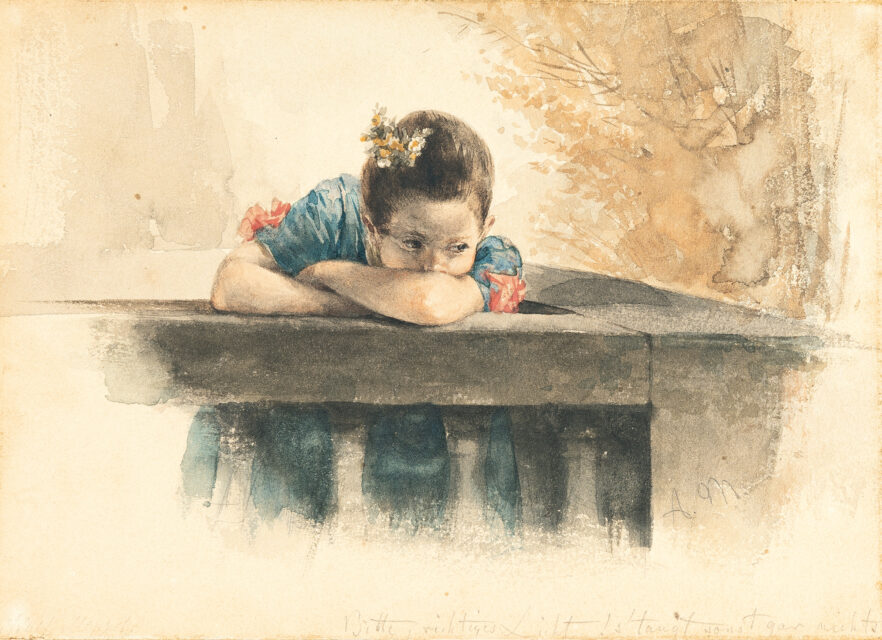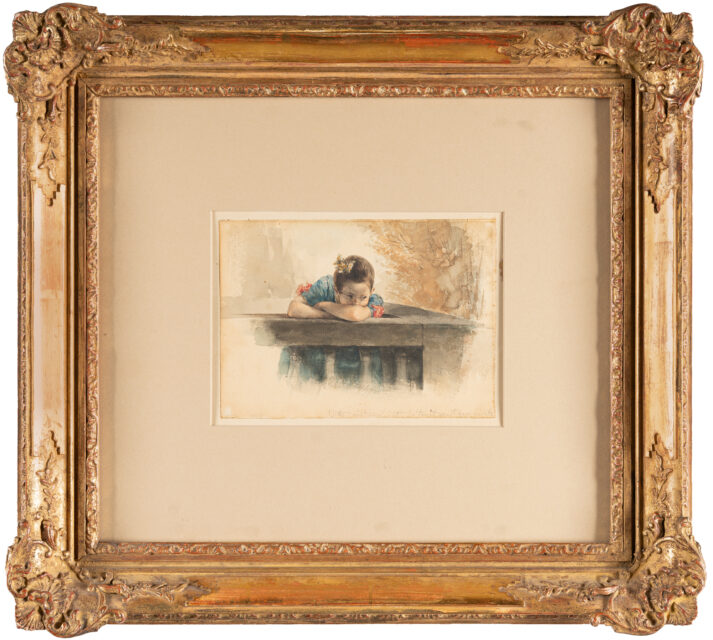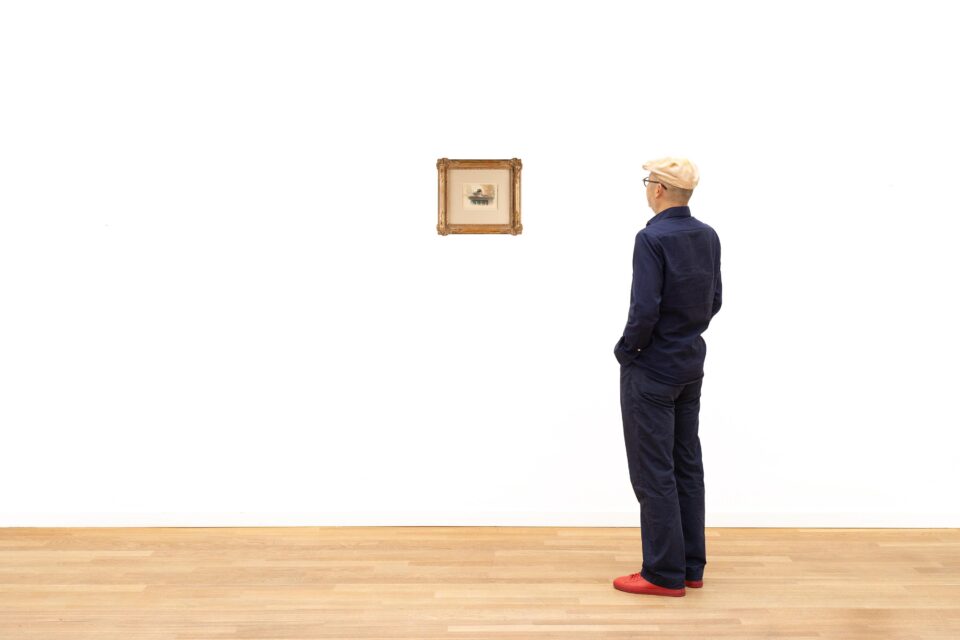Girl leaning on a balustrade
Details
Tschudi 294.
Literatur:
Hugo von Tschudi (Hrsg.), Adolph von Menzel. Abbildungen seiner Gemälde und Studien auf Grund der von der Kgl. Nationalgalerie im Frühjahr 1905 veranstalteten Ausstellung unter Mitwirkung von Dr. F. Schwedeler-Meyer und Dr. J. Kern, München 1905, S. 210, Kat.-Nr. 294, mit Abb. S. 211.
Ausstellung:
Ausstellung von Werken Adolph von Menzels 1905, Königliche Nationalgalerie, Berlin 1905, S. 25, Kat.-Nr. 329;
Galerie Thannhauser, Berlin: Adolph von Menzel. 1815–1905. Ausstellung von Gemälden, Gouachen, Pastellen, Zeichnungen in unserem Berliner Haus Bellevuestrasse 13. April 1928, Kat.-Nr. 72.
Provenienz:
Robert Warschauer (1860–1918), Berlin;
Wohl Daniel B. Grossman Gallery, New York (frühe 1980er Jahre);
Privatbesitz, Deutschland, wohl in obiger Galerie vor 1984 erworben;
Kunsthandlung J.P. Schneider, Frankfurt, verso auf der Rahmenrückwand mit dem verblassten Galeriestempel, der Lagerbuchnummer “5627” und dem Etikett der Kunsthandlung mit der Beschriftung “05414 A. Menzel”, 1984 von obigem Sammler erworben;
Privatbesitz, Deutschland, 1985, von obiger Kunsthandlung J.P. Schneider erworben;
1986 zurück in Kommission an Kunsthandlung J.P. Schneider, Frankfurt;
von obiger 1998 verkauft;
seitdem in Privatbesitz, Süddeutschland.
Descrizione
A young girl is leaning on a balustrade, just tall enough to rest her arms and head comfortably on it. She is festively dressed in a blue dress with red ruffles on the short sleeves, spring flowers in her hair, which is combed back and tied in a plait. She is the focal point, as Menzel has also placed her on the small sheet, with only the stone balustrade remaining, which, like the rest of the surroundings, is already beginning to “dissolve” to the sides – only a few brushstrokes indicate a bush on the right that is fading into the watercolours, while on the left behind the girl, very delicate, broadly painted brushstrokes seem to suggest further trees. Only the balustrade is clearly recognisable; it obviously delimits a terrace onto which the girl has run out and is alone for a moment.
It is a snapshot in which the girl feels unobserved, but Menzel observes her closely – he depicts the girl almost frontally, but his eyes are directed to the right – what might she be observing, where might her thoughts be wandering? The balustrade still limits his actions, but his thoughts already go beyond it – perhaps his thoughts already go beyond what is beyond childhood? The subtle observer Menzel opens up spaces of thought that go beyond mere existence and allow us to immerse ourselves in the child’s world of thought.
The sheet previously bore the neutral title “Girl at the Balustrade”, but on the reverse was the inscription “Daughter of staff physician Dr Puhlmann (friend of Menzel)/in Potsdam”. Friedrich Wilhelm Puhlmann (1797-1882) was a regimental doctor in Potsdam and had married Constanze Steinert in 1828, the year of his licence to practise medicine, with whom he had three sons and a daughter, the first-born Sophie (1830-1878). Puhlmann, who was one of the founding members of the Kunstverein in Potsdam in 1834, had known Menzel since 1836 at the latest, when he ordered a lithograph dedicated to the members of the Kunstverein from the 20-year-old in his capacity as chairman of the Kunstverein in the autumn. This was the beginning of a warm friendship that brought Menzel back to Potsdam and also to the Puhlmann family during his work on the illustrations for King Frederick II.
On these occasions, Menzel, who always drew, also repeatedly sketched in the Puhlmann house – “Puhlmann’s Bookshelf” (Staatliche Museen zu Berlin, Kupferstichkabinett) or the backyard of the Puhlmann house (Hamburger Kunsthalle), both from 1844, are well known. He portrayed his friend and his friend’s wife; Menzel was also familiar with their daughter, who was simply “Sophiechen” to him, and drew her several times – around 1841 and 1844, even as a teenager. Our sheet must have been created earlier, around 1837/38, when Sophie was about eight years old – although only general physiognomic similarities can be seen in the various drawings, the identification of the girl as Sophie is also credible because the Puhlmanns had an open-air country house with a large terrace enclosed by a similar balustrade.
Menzel, who never saw himself as a portraitist, repeatedly observed his family surroundings and those of his closest friends, such as the Maerker and Arnold families, especially in his early years, and created watercolours of them, which show his sister Emilie or his brother Richard, but also friends in moments when they feel unobserved. Our watercolour is the earliest in this series of remarkable portraits by Menzel. – Paper with minimal time-staining and foxing, otherwise in good condition.
Dr Peter Prange
We would like to thank Dr Claude Keisch, Berlin, for kind advice on cataloguing this lot.
* Tutte le informazioni includono la commissione a carico dell'acquirente (27%) senza IVA e senza garanzia. Salvo errori.
** Tutte le informazioni più la commissione a carico dell'acquirente e l'IVA e senza garanzia. Salvo errori.
*** Con riserva: L'offerta è stata accettata al di sotto del limite. L'acquisizione dell'opera potrebbe essere ancora possibile nella nostra vendita post-asta.
R = Le opere d'arte regolarmente tassate
N = Opere d'arte soggette a tassazione differenziata e provenienti da un paese non UE
Non è consentita la riproduzione e la distribuzione privata o commerciale di tutte le illustrazioni delle opere esposte nell'archivio della mostra e dell'asta. Tutti i diritti riservati.




